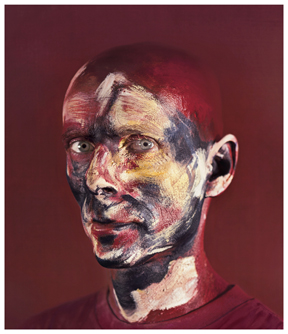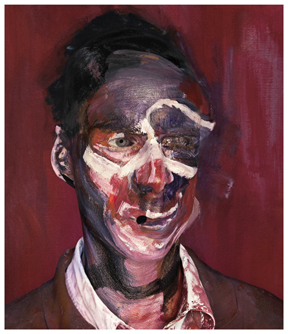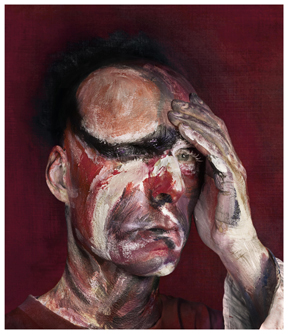Dance: Michael Platnik talks about movement and its influence on his work
By Michael Platnik
ART TIMES Fall 2014
 After three studies for Portrait of Lucien Freud |
In my early twenties a friend and I created a ticket office for students. We would go to the theater nearly every night, to contemporary dance performances and then we would write critiques. This is where I first met the physical theatre with Ariane Mnouchkine at the Theatre du Soleil. The amazing power of the characters, the mise-en-scene, the décor, the costumes, everything was just there to create a world, a closed system that could live by itself, independently. I remember I was so amazed by the movements of the characters and their expressions. I encountered this power again but in a completely different expression, a lot softer with Marcel Marceau and his amazing body expression. His sole presence was also creating a new world, another possibility for the creation of a closed independent system.
It was only in my late twenties that I started to study theater acting. In my thirties I went deeper into physica. You can do better I'm sure, but I thought I'd pass it on.
Theatre: The emphasis of my studies was on the methods of Jacques Lecoq and Etienne Decroux. With Jacques Lecoq I was mostly influenced by the work with the masks that aimed at cleaning the expression of the body from any mannerism. Even if I did not do a lot of stage combat, I think it was part of learning to find my own expression, my own strengths.
 After three studies for Portrait of Lucien Freud |
With the method of Etienne Decroux, the isolation of body parts within each movement had a great affect on me, in learning how to build a narrative with the body and the power of each movement in its ability to communicate a story or an emotion.
Later on (through books and visuals, not actual acting) I discovered the Bauhaus performances and their principle of 'total art work'. Oscar Schlemmer emphasized the 'object' quality of the dancers, transforming them into puppets, propelled by means of precise mechanism. In what he defined as 'sensation of space', and 'felt volume', he tried to unify the dancing figure with the geometrical property of the space. My works 'Self-Portrait in a Pool, 2009' or 'Self-Portrait in Red, 2010', 'Self-Portrait in White, 2010' are obviously very much influenced by his works.
Then there was the Black Mountain College with the collaboration of John Cage and Merce Cunningham. I was struck by their combination of accuracy in building space, chorographical phrases and the usage of chance. The framework is perfectly built, thought, and then it finally becomes alive at the moment of the performance where everything is subject to chance, the unplanned is life, it is the creation, it is not controllable.
 After three studies for Portrait of Lucien Freud |
I suppose at that point the Zen Buddhism influence of Cage and my own practice of martial arts intersected. The intense preparation of the mind and body with the aim of simply living with awareness. The best fighter is the one who does not enter fights, because the enemy understands even before the fight starts that he has no chance to win. Martial Arts help the development of this intense moment of the meeting with the other where everything is said with no words. Just like in the artworks from these performers and choreographers I mentioned. All the preparation of Cunningham just to be able to live the moment in its full intensity.
I believe that when creating these works dealing with Bacon, I searched for these same moments of intensity. I created a space for each of the characters, a living environment for them, then prepared costumes and painted on them and on the characters, directly on their bodies. The preparation of the characters during filming of my works take a very long time, models are tired and at some point forget that the camera will be filming, they don't have the expectation of seeing their own image anymore, of liking it, ego is neutralized. And then I start filming. With a Merce like throw of the dice, I put the character inside the set and start filming. My directing part is minimal, I let the character live in the structure of the set.
The presentation of the works at Gordon Gallery, Tel-Aviv, May 2014 as well have been very much influenced by theatre where the spectator enters into a world disconnected from everyday material life. Visual references to life are made only via art history, and the sensorial meeting between the visitor and the space created starts while encountering the essence of both the characters and the media in the Artworks.
